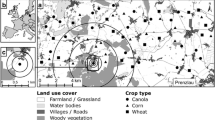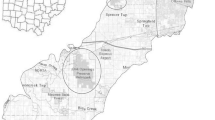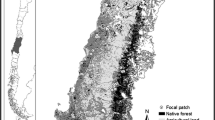Abstract
The present study examines those features which promote bat feeding in agricultural riparian areas and the riparian habitat associations of individual species. Activity of Nathusius’ pipistrelle (Pipistrellus nathusii), common pipistrelle (Pipistrellus pipistrellus), soprano pipistrelle (Pipistrellus pygmaeus), Leisler’s bat (Nyctalus leisleri), and Myotis species (Myotis sp.) were recorded, and their habitat associations both “between” and “within” riparian areas were analyzed. General feeding activity was associated with reduced agricultural intensity, riparian hedgerow provision, and habitat diversity. Significant habitat associations for P. pipistrellus were observed only within riparian areas. Myotis species and P. pygmaeus were significantly related to indices of landscape structure and riparian hedgerow across spatial scales. Myotis species were also related to lower levels of riffle flow at both scales of analysis. The importance of these variables changed significantly, however, between analysis scales. The multi-scale investigation of species–habitat associations demonstrated the necessity to consider habitat and landscape characteristics across spatial scales to derive appropriate conservation plans.

Similar content being viewed by others
References
Anonymous (1995) Biodiversity: the UK action plan. HMSO, London
Barlow KE (1997) The diets of two phonic types of the bat Pipistrellus pipistrellus in Britain. J Zool 243:597–609
BCT (2006) The National Bat Monitoring Programme—Annual Report 2005. Bat Conservation Trust, London
Brown AV, Brussock PP (1991) Comparisons of benthic invertebrates between riffles and pools. Hydrobiologia 220:99–108
Bogdanowicz W, Fenton MB, Daleszczyk K (1999) The relationships between echolocation calls, morphology and diet in insectivorous bats. J Zool 247:381–393
Burnham KP, Anderson DR (2002) Model selection and multimodel inference: a practical information–theoretic approach. Springer, New York
Compton BW, Rhymer JM, McCollouh M (2002) Habitat selection by wood turtles (Clemmys insculpta): an application of paired logistic regression. Ecology 83:833–843
Dietz M, Kalko EKV (2006) Seasonal changes in daily torpor patterns of free-ranging female and male Daubenton’s bats (Myotis daubentonii). J Comp Physiol 176:223–231
Dietz M, Encarnacao JA, Kalko EKV (2006) Small scale distribution patterns of female and male Daubenton’s bats (Myotis daubentonnii). Acta Chiropterologica 8:403–415
Davidson-Watts I, Jones G (2006) Differences in foraging behaviour between Pipistrellus pipistrellus (Schreber, 1774) and Pipistrellus pygmaeus (Leach, 1825). J Zool 268:52–68
Encarnacao JA, Kierdof U, Wolters (2006) Seasonal variation in nocturnal activity of male Daubenton’s bats, Myotis daubentonii (Chiroptera: Vespertilionidae). Folia Zool 55:237–246
Encarnacao JA, Kierdof U, Holweg D et al (2005) Sex related differences in roost-site selection by Daubenton’s bats Myotis daubentonii during the nursery period. Mammal Rev 35:285–294
Environment Agency (2002) River habitat survey database, version 3.3. Environment Agency, UK
Eurostat. (2008) Farm structure survey. In: Agriculture, Forestry and Fisheries. Eurostat. http://ec.europa.eu/eurostat. Accessed 20 Nov 2008
Fenton MB (1990) The foraging behavior and ecology of animal-eating bats. Can J Zool 68:411–422
Fielding AH, Bell JF (1997) A review of methods for the assessment of prediction errors in conservation presence/absence models. Environ Conserv 24:38–49
Gibson LA, Wilson BA, Cahill DM et al (2004) Spatial prediction of rufous bristlebird habitat in a coastal heathland: a GIS-based approach. J Appl Ecol 41:213–223
Glendell M, Vaughan N (2002) Foraging activity of bats in historic landscape parks in relation to habitat composition and park management. Anim Conserv 5:309–316
Grindal SD, Morissette JL, Brigham RM (1999) Concentration of bat activity in riparian habitats over an elevation gradient. Can J Zool 77:972–977
Griffin DR, Webster FA, Michael CR (1960) The echolocation of flying insects by bats. Anim Behav 8:141–154
Hayes JP (1997) Temporal variation in activity of bats and the design of echolocation-monitoring studies. J Mammal 78:514–524
JNCC (2000) Handbook for phase 1 habitat survey—a technique for environmental audit. Joint Nature Conservation Committee, Peterborough
Jones G, Rydell J (1994) Foraging strategy and predation risk as factors influencing emergence time in echolocating bats. Philos Trans R Soc Lond Ser B 346:445–455
Kalko EKV, Schnitzler HU (1989) The echolocation and hunting behavior of Daubenton’s bat, Myotis daubentonii. Behav Ecol Sociobiol 24:225–238
Keating KA, Cherry S (2004) Use and interpretation of logistic regression in habitat-selection studies. J Wild Manage 68:774–789
Leopold LB, Wolman MG, Millar JP (1964) Fluvial processes in geomorphology. Miller, San Francisco
McAlpine C, Rhodes AJR, Callaghan J et al (2006) The importance of forest area and configuration relative to local habitat factors for conserving forest mammals: a case study of koalas in Queensland, Australia. Biol Conserv 132:152–165
McGarigal K, Marks BJ (1995) FRAGSTATS: spatial pattern analysis program for quantifying landscape structure. General technical report PNW-GTR-351 Department of Agriculture and Forest Service, Pacific Northwest Research Station. Portland, Oregon
MacNally R (2000) Regression and model building in conservation biology, biogeography and ecology: the distinction between and reconciliation of ‘predictive’ and ‘explanatory’ models. Biodiversity Conserv 9:655–671
Marshall EJP (2004) Agricultural landscapes: field margin habitats and their interaction with crop production. J Crop Imp 12:365–404
Mickleburgh SP, Hutson AM, Racey PA (2002) A review of the global conservation status of bats. Oryx 36:18–34
Moran JL, Jefferies RL (2001) Restoring enriched grasslands effects of mowing on species richness, productivity and nitrogen retention. Ecol Appl 11:1088–1100
Nicholls B, Racey PA (2006) Contrasting home-range size and spatial partitioning in cryptic and sympatric Pipistrelle bats. Behav Ecol Scoio 61:131–142
Norberg UM, Rayner JMV (1987) Ecological morphology and flight in bats (Mammalia; Chiroptera): wing adaptations, flight performance, foraging strategy and echolocation. Philos Trans R Soc Lond Ser B 316:335–427
O’Sullivan P (1994) Bats in Ireland. Ir Nat J 24:1–21
Ormerod SJ, Marshall EJP, Kerby G et al (2003) Meeting the ecological challenge of agricultural change: editors introduction. J Appl Ecol 40:939–946
Parsons S, Jones G (2000) Acoustic identification of twelve species of echolocating bat by discriminant function analysis and artificial neural networks. J Exp Biol 203:2641–2656
Racey PA (1998) The importance of the riparian environment as a habitat for British bats. In: Dunstone N, Gorman ML (eds) Behaviour and ecology of riparian mammals. Cambridge University Press, Cambridge, pp 69–90
Russ J (1999) The Bats of Britain and Ireland: echolocation calls, sound analysis and species identification. Alana Ecology, England
Russ JM, O'Neill JK, Montgomery WI (1999) Nathusius' pipistrelle (Pipistrellus nathusii, Keyserling & Blasius) breeding in Ireland. J Zool 245:345–349
Russ JM, Montgomery WI (2002) Habitat associations of bats in Northern Ireland: implications for conservation. Biol Conserv 108:49–58
Russo D, Jones G (2003) Use of foraging habitats by bats in a Mediterranean area determined by acoustic surveys: conservation implications. Ecography 26:197–209
Rydell J (1992) Exploitation of insects around streetlamps by bats in Sweden. Funct Ecol 6:744–750
Rydell J, Miller LA, Jensen ME (1999) Echolocation constraints of Daubenton's Bat foraging over water. Funct Ecol 13:247–255
Sattler T, Bontadina F, Hirzel AH et al (2007) Ecological niche modelling of two cryptic bat species calls for a reassessment of their conservation status. J Appl Ecology 44:1188–1199
Shiel CB, Fairley JS (1998) Activity of Leisler’s bat Nyctalus leisleri (Kuhl) in the field in south-east County Wexford, as revealed by a bat detector. Biol Envir 98:105–112
Shiel CB, Shiel RE, Fairley JS (1999) Seasonal changes in the foraging behaviour of Leisler’s bats (Nyctalus leisleri) in Ireland as revealed by radio-telemetry. J Zool London 249:347–358
Speakman JR, Thomas DW (2003) Physiological ecology and energetics of bats. In: Kunz TH, Fenton MB (eds) Bat ecology. University of Chicago Press, London, pp 430–492
Stanford JA, Ward JV, Liss WJ et al (1998) A general protocol for restoration of regulated rivers. Regul Rivers Res Manage 12:391–413
Stephens PA, Buskirk SA, Hayward GD et al (2005) Information theory and hypothesis testing: a call for pluralism. J Appl Ecol 42:4–12
Vaughan N, Jones G, Harris S (1997) Habitat use by bats (Chiroptera) assessed by means of a broadband acoustic method. J Appl Ecol 34:716–730
Walsh A, Harris S (1996) Foraging habitat preferences of vespertilionid bats in Britain. J Appl Ecol 33:508–518
Walsh C, Mac Nally R (2003) The hier.part Package: Hierarchical Partitioning. R Foundation for Statistical Computing, Vienna. http://cran.r-project.org/web/packages/hier.part
Warren RD, Water DA, Alteringham et al (2000) The distribution of Daubenton's bats (Myotis daubentonii) and pipistrelle bats (Pipistrellus pipistrellus) (Vespertilionidae) in relation to small-scale variation in riverine habitat. Biol Conser 92:85–91
Whilde A (1993) Threatened mammals, birds, amphibians and fish in Ireland. Irish Red Data Book 2: Vertebrates. HMSO, Belfast
Wickramasinghe LP, Harris S, Jones G et al (2003) Bat activity and species richness on organic and conventional farms: impact of agricultural intensification. J Appl Ecol 40:984–993
Willis KJ, Whittaker RJ (2002) Species diversity—scale matters. Science 295:1245–1248
Acknowledgments
We are grateful to the two anonymous reviewers for their valuable comments and suggestions on the manuscript. This research was funded by the Department of Employment and Learning, Northern Ireland.
Author information
Authors and Affiliations
Corresponding author
Additional information
Communicated by H. Kierdorf
Rights and permissions
About this article
Cite this article
Lundy, M., Montgomery, I. Summer habitat associations of bats between riparian landscapes and within riparian areas. Eur J Wildl Res 56, 385–394 (2010). https://doi.org/10.1007/s10344-009-0330-z
Received:
Revised:
Accepted:
Published:
Issue Date:
DOI: https://doi.org/10.1007/s10344-009-0330-z




